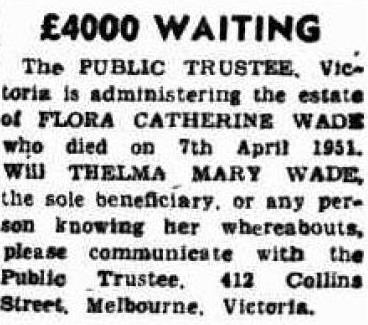
by Tracie Griffith
The story of the Cox Street Axe Murder continues to intrigue, with the question of what happened to Thelma Mary Wade remaining unanswered. It appears that little Stewart Wade was not the only victim of his mother’s senseless crime. Known accounts suggest that Thelma led a troubled existence; potentially suffering from the same mental illness as her mother and possibly dying a lonely and anonymous death.
Probate documents gathered for the administration of Flora Wade’s estate provide the only clues as to what happened after Flora’s release from Sunbury Asylum in 1921. Flora’s will was dated 7th June 1932 and she left her entire estate to her daughter. The two women were living together at a property in Carnegie when the will was drawn up and continued to do so until Flora was delivered to a receiving house at Royal Park on 17th June 1945. There is no information on the events that surrounded her admittance. Flora remained in mental hospitals until her death in 1951 at the age of 74.
Disturbingly, Thelma was admitted to the same receiving house on 28th June 1945, but was discharged four days later on 2nd July 1945. Thelma’s admission form states that she was 30 years old, but she was actually 34 at the time. After her discharge, she remained at a mental hospitals’ aftercare hostel in Hawthorn until 8th August. During this period she requested permission to continue residing at her mother’s house in Carnegie. This request was granted, but investigations indicated that she never returned to the premises. Thelma left the aftercare facility and simply disappeared.
Thelma had never married. A friend reported that she had spoken of entering a convent, but enquiries along those lines proved negative. A former work colleague reported sighting Thelma in Albury in September 1945, but the NSW police and lunacy authorities could find no trace of her in that state. There was no Victorian death record and the last transaction on her bank account at the State Savings Bank in Glenhuntly was dated 3rd November 1944. The aftercare hostel still had possession of a quantity of Thelma’s clothes and a friend was still holding thirty pounds given to her for safekeeping.
Perhaps Thelma decided to change her identity and leave her former life behind, in which case she wouldn’t want to be found. Perhaps she met with foul play. Certainly the circumstances of her disappearance were unusual and warranted further investigation. Whatever ultimately happened to Thelma Mary Wade, it is clear the course of her life was irretrievably altered by the events of 13th November 1916 and she continued to be haunted by the crime that ended her brother’s young life.
Note: Thelma’s name is listed as Mary Thelma Wade on her birth certificate, but the use of her first and second names was reversed at some stage, possibly after the events of 1916. Her age may also have been deliberately obscured.